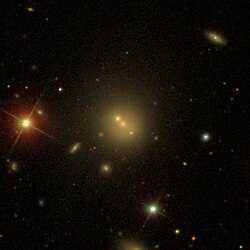
NGC 5821 is a spiral galaxy with a ring structure in the constellation Boötes. It lies near a similarly massed galaxy, NGC 5820, at the same redshift. Both galaxies were discovered by the astronomer William Herschel.
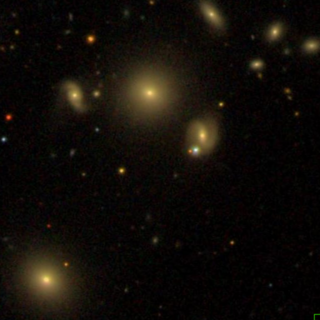
NGC 3552 is a lenticular galaxy in the constellation Ursa Major. It was discovered on April 11, 1785 by William Herschel. It is a member of the galaxy cluster Abell 1185.

NGC 3554 is an elliptical galaxy in the constellation Ursa Major. It was discovered in December 1827 by John Herschel.

NGC 3539 is a lenticular galaxy in the constellation Ursa Major. It was discovered in April 1831 by John Herschel. It is a member of the galaxy cluster Abell 1185.

NGC 4780 is an intermediate spiral galaxy within the constellation Virgo. It is located about 166 million light-years away from the Sun. It was discovered in 1880 by the astronomer Wilhelm Tempel.
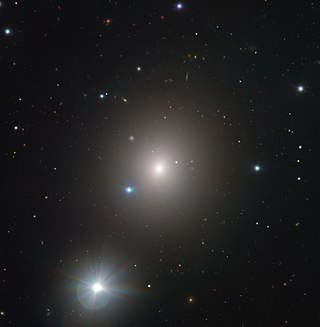
NGC 1404 is an elliptical galaxy in the Southern constellation Eridanus. It was discovered on November 28, 1837, by the astronomer John Herschel. Based on the tip of the red-giant branch distance indicator, it lies at a distance of approximately 60 million light-years from the Milky Way. It is one of the brightest members of the Fornax Cluster.
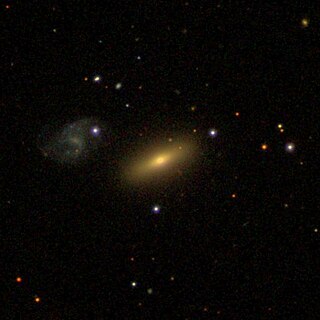
NGC 42 is a lenticular galaxy in the Pegasus constellation. It was discovered on October 30, 1864, by the German astronomer Albert Marth. It may be gravitationally interacting with the nearby NGC 41.

NGC 1728 is a spiral galaxy in the constellation Eridanus. The galaxy is listed in the New General Catalogue. It was discovered on November 10, 1885 by the astronomer Edward Emerson Barnard.
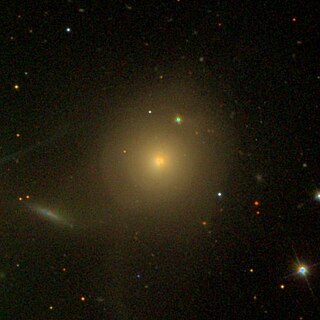
NGC 467 is an unbarred lenticular galaxy in the constellation Pisces. It was discovered on 8 October 1785 by William Herschel.

NGC 3359 is a barred spiral galaxy located 59 million light-years from Earth, in the constellation of Ursa Major. It was discovered on November 28, 1793, by the astronomer William Herschel. The central bar is approximately 500 million years old.

NGC 178 is a Magellanic spiral galaxy in the constellation of Cetus. The compiler of the New General Catalogue, John Louis Emil Dreyer noted that NGC 178 was "faint, small, much extended 0°, brighter middle". It was discovered on November 3, 1885 by Ormond Stone.

NGC 470 is a spiral galaxy in the constellation Pisces. Located approximately 91 million lightyears from Earth, it was discovered by Friedrich Wilhelm Herschel in 1784. The galaxy also weakly interacts with NGC 474.

NGC 479 is a spiral galaxy in the constellation Pisces. It was discovered by German astronomer Albert Marth on October 27, 1864. It is about 240 million light-years away from Earth.

NGC 3319 is a barred spiral galaxy in the constellation Ursa Major. It was discovered by William Herschel on Feb 3, 1788. It is rich in gas and lacks a galactic bulge.
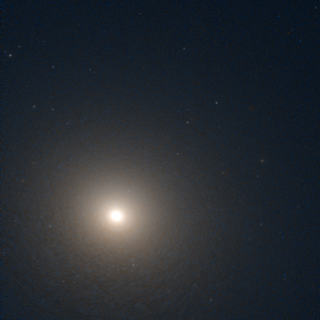
NGC 1400 is an elliptical galaxy in the constellation Eridanus. At a distance of 65 million light-years from Earth, it was discovered by John Herschel in 1786. It is a member of the NGC 1407 group, whose brightest member is NGC 1407. The NGC 1407 group is part of the Eridanus Cluster, a cluster of 200 galaxies.

NGC 531 is a barred spiral galaxy in the constellation Andromeda with a visual magnitude of 10.51. It is a distance of 65.7 Mpc from the Sun. It is a member of the Hickson Compact Group HCG 10, and is interacting with the other members of the group.

NGC 535 is a lenticular galaxy in the constellation Cetus. It is estimated to be 222 million light years from the Milky Way and has a diameter of approximately 65,000 light years. The supernova SN 1988ad was observed near these coordinates. NGC 535 was discovered on October 31, 1864, by astronomer Heinrich Ludwig d'Arrest.

NGC 706 is a spiral galaxy located in the Pisces constellation about 230 million light years from the Milky Way. It was discovered by the German–British astronomer William Herschel in 1786.

NGC 5619 is an intermediate spiral galaxy in the constellation Virgo. The galaxy was found on April 10, 1828 by the British astronomer John Herschel. It is located about 390 million light-years away from the Sun.

NGC 3073 is a dwarf lenticular galaxy in the constellation Ursa Major. It is at a distance of about 65 million light-years from Earth. NGC 3073 was discovered by astronomer William Herschel on April 1, 1790. The galaxy belongs to the NGC 3079 Group.
